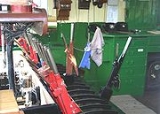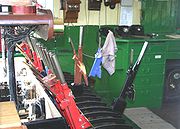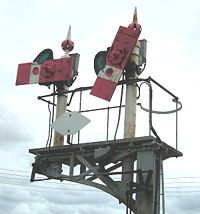
Rule 55
Encyclopedia
Rule 55 was an operating rule which applied on the former British Railways
in the 19th century, and was made defunct when the Modular Rulebook was introduced following privatisation of the railway
.
 Rule 55 was introduced following a spate of accidents caused by signalmen
Rule 55 was introduced following a spate of accidents caused by signalmen
forgetting that trains were standing on a running line, sometimes within sight of their signal box
es.
It required that, if a train
was brought to a stand at a signal, within three minutes in clear weather or immediately in rain, snow or fog, the driver of the train must despatch his fireman, guard or any shunter riding on the train, to the signal box to ensure that the signalman was aware of the presence of the train, and that all safeguards to protect the train, such as slides or collars on the signal levers, were in place, the crewman then signing the train register to confirm this.
In practice, this usually meant a fruitless trudge, often in foul weather, for the unfortunate crewman (although there was usually a mug of tea to be had in the signal box). Quite often the rule was obeyed only perfunctorily, the crewman merely exchanging a greeting with the signalman before signing the register and departing. In many cases, such as at major junctions or marshalling yards where crewmen walking along the rails were in grave danger from moving trains, the rule could not be applied properly. Further, the need for the fireman to return to the train would delay it if the signal was cleared in the meantime.
, the crews of the standing trains failed to carry out the rule. At Quintinshill
, the fireman of the standing train signed the register but did not ensure that the signalman had put the necessary safeguards in place.
 It is impossible to know how many accidents were prevented by the proper observation of the rule, and it could not always prevent a crash. At Winwick
It is impossible to know how many accidents were prevented by the proper observation of the rule, and it could not always prevent a crash. At Winwick
, a train was brought to a stand some distance from the signal box. The fireman left promptly to carry out the rule, but he had not reached the signal box before his train was struck. To prevent such occurrences, 'call plungers' (which operate an indicator in the signal box when pressed) or telephones were installed at some signal posts, or track circuit
s installed.
s or similar means.
Rules are no longer given names, but instead are referred to by the section of the Rule Book in which they are placed. In this case it is Module S4/section 1, which states;
"When your train is detained at a signal at danger on a running line, you must remind the signaller.
Except as otherwise shown in this module, you must contact the signaller as soon as possible.
However, you can wait for up to two minutes before contacting the signaller if you can see an obvious reason for the signal to be at danger such as:
• the section ahead being occupied by a train
• a conflicting movement being made at a junction."
British Rail
British Railways , which from 1965 traded as British Rail, was the operator of most of the rail transport in Great Britain between 1948 and 1997. It was formed from the nationalisation of the "Big Four" British railway companies and lasted until the gradual privatisation of British Rail, in stages...
in the 19th century, and was made defunct when the Modular Rulebook was introduced following privatisation of the railway
Privatisation of British Rail
The privatisation of British Rail was set in motion when the Conservative government enacted, on 19 January 1993, the British Coal and British Rail Act 1993 . This enabled the relevant Secretary of State to issue directions to the relevant Board...
.
Overview

Signalman (rail)
A signalman or signaller is an employee of a railway transport network who operates the points and signals from a signal box in order to control the movement of trains.- History :...
forgetting that trains were standing on a running line, sometimes within sight of their signal box
Signal box
On a rail transport system, signalling control is the process by which control is exercised over train movements by way of railway signals and block systems to ensure that trains operate safely, over the correct route and to the proper timetable...
es.
It required that, if a train
Train
A train is a connected series of vehicles for rail transport that move along a track to transport cargo or passengers from one place to another place. The track usually consists of two rails, but might also be a monorail or maglev guideway.Propulsion for the train is provided by a separate...
was brought to a stand at a signal, within three minutes in clear weather or immediately in rain, snow or fog, the driver of the train must despatch his fireman, guard or any shunter riding on the train, to the signal box to ensure that the signalman was aware of the presence of the train, and that all safeguards to protect the train, such as slides or collars on the signal levers, were in place, the crewman then signing the train register to confirm this.
In practice, this usually meant a fruitless trudge, often in foul weather, for the unfortunate crewman (although there was usually a mug of tea to be had in the signal box). Quite often the rule was obeyed only perfunctorily, the crewman merely exchanging a greeting with the signalman before signing the register and departing. In many cases, such as at major junctions or marshalling yards where crewmen walking along the rails were in grave danger from moving trains, the rule could not be applied properly. Further, the need for the fireman to return to the train would delay it if the signal was cleared in the meantime.
Accidents
Failure to apply the rule properly was a factor in several railway accidents in the period from 1890 onwards. At Thirsk and Hawes JunctionHawes Junction rail crash
The Hawes Junction rail crash occurred on 24 December 1910, on the Midland Railway's Settle and Carlisle mainline at the junction with the Wensleydale Railway in Westmorland , England. It was caused when a busy signalman forgot about a pair of light engines waiting at his down starting signal to...
, the crews of the standing trains failed to carry out the rule. At Quintinshill
Quintinshill rail crash
The Quintinshill rail disaster occurred on 22 May 1915 in Scotland near Gretna Green at Quintinshill, an intermediate signal box with sidings on each side on the Caledonian Railway Main Line . The crash involved five trains and killed 226 people...
, the fireman of the standing train signed the register but did not ensure that the signalman had put the necessary safeguards in place.

Winwick rail crash
The Winwick rail crash took place at Winwick Junction, near Warrington on the London, Midland and Scottish Railway, on 28 September 1934.-Background:...
, a train was brought to a stand some distance from the signal box. The fireman left promptly to carry out the rule, but he had not reached the signal box before his train was struck. To prevent such occurrences, 'call plungers' (which operate an indicator in the signal box when pressed) or telephones were installed at some signal posts, or track circuit
Track circuit
A track circuit is a simple electrical device used to detect the absence of a train on rail tracks, used to inform signallers and control relevant signals.- Principles and operation :...
s installed.
Exemption
A white diamond sign on a signal post indicated to the driver that Rule 55 did not apply at that signal (at which no telephone was provided), due to the train being protected by track circuitTrack circuit
A track circuit is a simple electrical device used to detect the absence of a train on rail tracks, used to inform signallers and control relevant signals.- Principles and operation :...
s or similar means.
Current rule
The basic principle of Rule 55 remains today. It has been updated as it is usually unnecessary for train crew to visit the signal box, since modern technology such as signal post telephones, in-cab radio, and mobile phones allows instant communication.Rules are no longer given names, but instead are referred to by the section of the Rule Book in which they are placed. In this case it is Module S4/section 1, which states;
"When your train is detained at a signal at danger on a running line, you must remind the signaller.
Except as otherwise shown in this module, you must contact the signaller as soon as possible.
However, you can wait for up to two minutes before contacting the signaller if you can see an obvious reason for the signal to be at danger such as:
• the section ahead being occupied by a train
• a conflicting movement being made at a junction."

